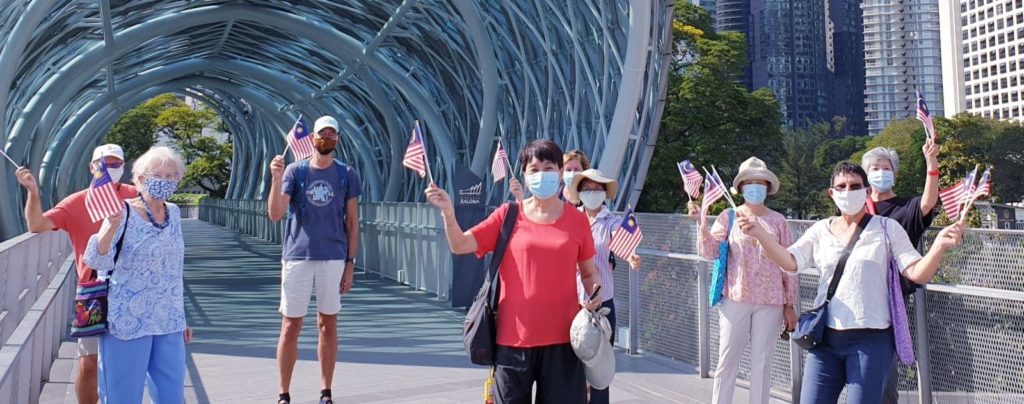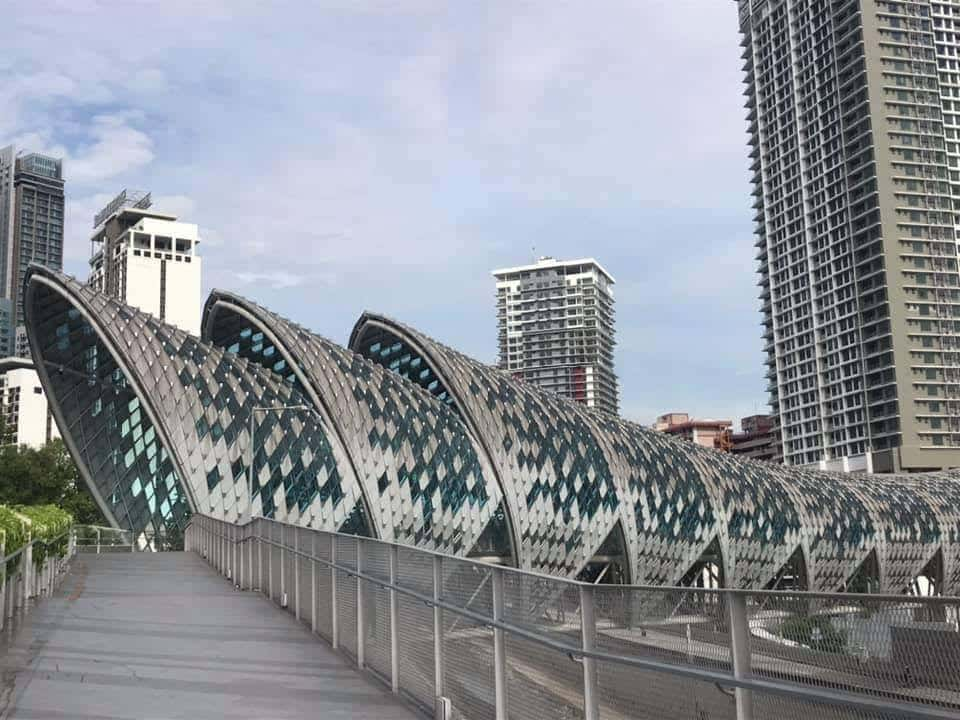The Saloma Bridge
Saloma, Saloma! A beautiful name for a beautiful singer and actress. Saloma was a Singaporean/Malay singer who was married in 1961 to P. Ramlee, another famous Malaysian singer, actor, songwriter, composer and director. Now her name graces the Saloma Bridge which was the highlight of our walking tour to Kampong Baru for the Enak! group of MCG.
Our guide Nadge Ariffin, a heritage conservation architect, told the 10 ladies in our Enak! group that the Saloma Link is a combined pedestrian and bicycle bridge linking the Kuala Lumpur City Centre to the Kampung Baru village across the Klang River and freeway. Before we crossed the bridge we stopped at the gate of the Jalan Ampang Muslim cemetery where both Saloma and P. Ramlee are buried.
Once on the bridge we could see it was an imposing structure, 69 metres long. Its architecture is inspired by the sireh janjung (betel nut leaf arrangement) which is an integral part of a Malay wedding. Nadge advised that it was very challenging to build as it has to cross a wide expanse of the river and freeway and also below was the LRT train line so extra care had to be undertaken for the footings. We all agreed that what eventuated is a beautiful design and practical too as the locals have been asking for a walkway for a long time to the city. The bridge is especially stunning at night as it is lit up with thousands of different LED lights showcasing the Malaysian flag colours or other decorative colours depending on the occasion.


The VERITAS Design Group designed the structure, which opened to the public on 5 February, 2020. The project cost 31 million RM.
Once over the bridge and after a few photos of our group, all physically distanced and wearing masks for safety, we continued to explore the actual destination of our tour: Kampung Baru.
Kampong Baru
Lying in the shadow of the KL Twin Towers is the 120-year old Malay enclave, Kampong Baru. It is a juxtaposition of a 21st century modern city and a nostalgic past belonging to early 20th century. Created through the Malay Agricultural Settlement Act (MAS), Ist January, 1900, it was dedicated to farming for 200 families. This was in response to the increasing food demand of an expanding mining town that was centred in Kuala Lumpur. Today, these settlers are into their fifth generation. Hence, there is the difficulty of resale due to these multiple ownerships (as many as 10 to 200 owners) for each individual property. However, modernity is already at its doorstep with the UDA mixed development project, Legasi Kampong Baru. The condominiums and shop lots are purported to be 96% sold out.
The cultural walk took us through neighbourhoods with many warungs, small businesses and modified Malay kampung houses. Only about 22 houses remained with their original design and structure. In part, rentals and the multiple ownerships made maintenance and upkeep difficult. We also came across what must have been the cheapest car wash station in Kuala Lumpur, at the price of RM5 per car wash, irrespective of vehicle.
Among the highlights are number 60, Jalan Alang, built in 1937, still owner occupied, the 1956 Masjid Jamek Mosque with its famous bubur lambok (rice porridge) and the 1953 rebuilt Perak style house owned by an English teacher. It was interesting to note that it is a two part building on stilts, with a mother house and a kitchen annex. The kitchen annex was built three steps lower than the main house. This separation was a practical solution in the event of a fire in the kitchen. The annex would simply be collapsed and the mother house would remain unscathed.
Foodies may want to try the ikan singgang at Restauran Istana Maju located to the right of the stairs at the bottom of the Saloma Bridge. Or try the all-time Malaysian favourite breakfast or all day food, the nasi lemak, at either the Nasi Lemak Antarabangsa shop (since the 1970s) or Wanjo Nasi Lemak shop. Those wanting to try the bubur lambok could do so at the stall near to the mosque which boasts of its original bubur lambok recipe, or if it is during the fasting month, free bubur would be distributed to everyone, with the limitation of up to four containers per person.
Patricia Chia Yoon Moi and Janine Williams
